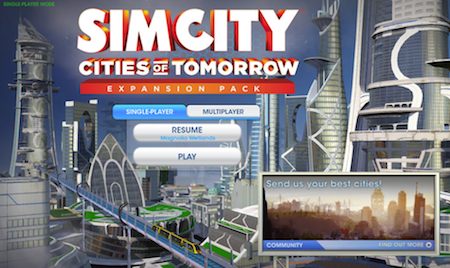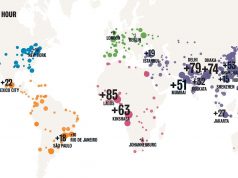MESH Cities–commonly known by their generic name Smart Cities–may well be a panacea for many of the world’s environmental, social, and economic challenges. Collectively, MESH Cities have the power to help re-energize civic participation while at the same time breathing life into the West’s stagnant economies. In spite of this renaissance-like potential, few understand where these generational disruptive technologies came from and where they may go. Our editor recaps some of the early research behind the smart cities movement then offers predictions on where they can take our economies.
Smart Cities as an aspiration got traction in policy circles about a generation ago. Back then the influential Dr. Bill Mitchell of MIT explored ICT-driven dematerialization of city infrastructure in his book, City of Bits. Mitchell makes this prediction about the future of digital cities and our place in them:
Networks at these different levels will all have to link up somehow; the body net will be connected to the building net, the building net to the community net, and the community net to the global net. From gesture sensors worn on our bodies to the worldwide infrastructure of communications satellites and long-distance fiber, the elements of the bitsphere will finally come together to form one densely interwoven system within which the knee bone is connected to the I-bahn.
By mid-2014 his forecast has proven true with Apps that tell us our heart rates feeding information to “the cloud.”.
Other researchers of the era including those at the Brookhaven National Laboratory also made public the ideas they thought were the next big thing—efficient cities. Going beyond Mitchell’s generalizations, the Brookhaven researchers dove deep into the technical infrastructure of connected cities.
Remember, it was a time when the commercial Internet was going insane over the ability to order pet food online. In spite of the bubble-era insanity these bright US researchers looked to the future, and that future was both clean and wired. They were convinced that the nirvana-like benefits offered cities by ubiquitous computing lay just over the horizon.
The researchers presented their work this way in 2000, one year before the events that changed everything. It is worth the read if only to remind people who are just now discovering the field that their work builds on the sweat of bleeding-edge researchers now generally forgotten:
The vision of “Smart Cities” is the urban center of the future, made safe, secure, environmentally green, and efficient because all structures – whether for power, water, transportation, etc. are designed, constructed, and maintained making use of advanced, integrated materials, sensors, electronics, and networks which are interfaced with computerized systems comprised of databases, tracking, and decision-making algorithms. The research and engineering challenges along the way to this vision encompass many technical fields including physics, chemistry, biology, mathematics, computing science, systems, mechanical., electronics and civil engineering. At the simplest level is the basic component and its associated “feedback” or self-monitoring mechanism(s).
Each must be identified or, if already existing, tailored for the appropriate application. At the next level is the design of the system making use of these components. Associated with this would be the interface to the computerized “monitoring” capability for each given function. Next, is the full structure or service supplied, and lastly, the integration of information across all related and seemingly unrelated aspects of an urban center’s essential infrastructure.
What does that vision mean when it comes to reducing humankind’s carbon footprint? The Carbon War Room published this statistic in February, 2013: “The total opportunity for ICT-enabled reductions is 9.1 Gt CO2e annually by 2020 . . .” That equals a 16.5% reduction in total CO2e emissions. But there is more. The sad truth behind climate change is that it is not part of some undetermined future. We are living it. See hurricane Sandy as just one example. Smart Cities can mitigate the damage caused by unusual weather and tides by making urban centres resilient. Brookhaven’s researchers explained how this way:
A city that monitors and integrates conditions of all of its critical infrastructures, including roads, bridges, tunnels, rail/subways, airports, sea ports, communications, water, power, even major buildings, can better optimize its resources, plan its preventive maintenance activities, and monitor security aspects while maximizing services to its citizens. Emergency response management to both natural as well as man-made challenges to the system can be focused and rapid. With advanced monitoring systems and built-in smart sensors, data can be collected and evaluated in real time, enhancing city management’s decision-making. For example, resources can be committed prior to a water main break, salt spreading crews dispatched only when a specific bridge has icing conditions, and use of inspectors reduced by knowing condition of life of all structures. In the long term Smart Cities vision, systems and structures will monitor their own conditions and carry out self-repair, as needed.
The physical environment, air, water, and surrounding green spaces will be monitored in non-obtrusive ways for optimal quality, thus creating an enhanced living and working environment that is clean, efficient, and secure and that offers these advantages within the framework of the most effective use of all resources. This paper discusses a current initiative being led by the Brookhaven National Laboratory to create a research, development and deployment agenda that advances this vision. This is anchored in the application of new technology to current urban center issues while looking 20 years into the future and conceptualizing a city framework that may exist.
Presented by: Robert E. Hall, Brookhaven National Laboratory Contributors: B. Bowerman J. Braverman J. Taylor H. Todosow U. von Wimmersperg
What is remarkable about this introduction is that a bright entrepreneur could just about take any one sentence from it and build a billion dollar company. Today, many are doing just that.
The Carbon War Room report goes on to describe the M2M (Machine to Machine) value chain:
Connecting the dots between these discrete functions will result in more than 12.5 billion deployed M2M devices by 2020. What does that do for major economies?
The connected machines of the industrial internet are capable of generating both cost savings and new revenues that in total could add $10–15 trillion to global GDP—the current size of the u.s. economy—over the next 20 years (evans & annunziata 2012).
Let’s get that straight. Building out smart, efficient cities will not only radically reduce greenhouse gasses, it will also add economic growth equal to the world’s largest economic engine.
Where do we sign up?
As we transition from so-called dirty economies, to clean, efficient, and even beautiful ones, it is important to remember that we also have to transition the role of workers in cities. Architects have for centuries brought tangible visions of beauty to those wealthy enough to afford it. What happens to civic economies when everyone participates in the value-added act of urban beautification? That is a job creation idea without limits. It is also an objective whose time has come, not in the least because we can no longer afford the resource waste inefficient economies thrive on.
Imagine economies not stuck with past constraints, but embracing and driven by new opportunities. Is that possible? Maybe not, but who in 1970 would have thought the vast repository of human knowledge would be accessible online in real time? At MESH Cities we like to say, “The future has arrived, it is just not evenly distributed.” And that’s just what we are doing.







